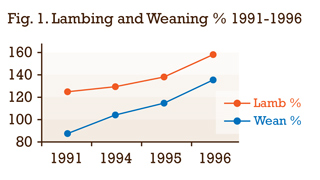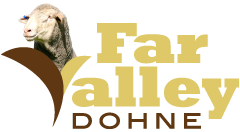By Cameron MacMaster
The following article is a South African farmers story written in 1997. This story has inspired 100's of Australian Sheep breeders into the Dohne breed. And yes, it can happen here too.
In the short space of six years, by switching to Dohne Merinos Inus Malan of Bredasdorp achieved a dramatic 240% improvement in gross margins. His experience is typical of what can be achieved by sheep breeders in Winter Rainfall areas.
Seventeen years ago Inus Malan inherited a farm stocked with Merinos. His farm is situated in the coastal plain ("vlakte") south of Bredasdorp and consists of equal areas of acidic and alkaline soils. The most severe constraint is the long dry summer that determines the stocking rate of breeding ewes. In contrast, the region has an abundant fodder flow in late winter and spring when lucerne and medic pastures are in full production. This flush must be fully exploited to realise optimum financial returns.
Inus Malan describes himself as a lazy farmer and not the ideal stockman. His philosophy is that his farm should care for him - and not he for his farm and livestock. As a consequence his systems have to be simple, easy and effective, with minimum effort and cost. After some years of perseverance with the flock he had inherited he realised that despite costly inputs and the utilisation of only the best parts of his farm, weaning percentages remained unacceptably low - as low as 75% in some years. Poor lamb growth rates necessitated lambing early (March / April) in order to market lambs before the onset of summer. However, this resulted in lower conceptions, higher pre-natal feeding and finishing costs. It soon became evident that for his enterprise to remain economically viable, drastic modifications to the production system would have to made.
New Strategy
At this stage he enlisted the help of Andre Fourie, livestock consultant of the Bredasdorp/Napier Agricultural Co-operative. With his Merinos the meat income was similar to the wool income. To raise income, it was clear that production strategy would have to be changed to generate much higher levels of lamb production at times of peak fodder flow. A three-prong strategy was decided upon:
- To shift the lambing season to July/August for better conception and to lamb at the height of the pasture growth cycle
- To shift the shearing time to February/March to facilitate the autumn mating
- To apply a rigorous culling programme to eliminate all ewes that failed to rear a lamb.
However, despite using the best rams and semen available, the reproduction rate could not be increased much over 95%, a large proportion of the later lambs could not be marketed before the onset of the dry summer season. To over-summer these unproductive sheep at high cost could not be economically justified and at the same time it meant that fewer breeding could be carried - a fatal weakness of the system that would drastically reduce turnover, cash flow and profitability. It was also in conflict with the philosophy of easy-care, low cost production, which Inus has set as his goal. He became very discouraged. As a member of the Bredasdorp Finrek Study Group he observed that, whereas his financial results fell within the lower third of the group, members with dual-purpose sheep were faring much better.
The Dohne Merino Option
In 1991 it was decided that a further drastic change to the production system was necessary - to adapt the sheep breed to the system, rather than to adapt the system to the breed he was using. It was decided to switch entirely to Dohne Merino rams. The faster growing lambs would hopefully overcome the problem of marketability before Christmas and at the same time enable him to at least maintain or even increase the number of breeding ewes that could be carried through the summer. The decision to switch breeds was not one that could be taken lightly, particularly in a district such as Bredasdorp where there was strong social pressure from traditional woolled sheep breeders against any change of this nature. However, an increasing number of ambitious young farmers in the district were then being influenced more by economic considerations than by tradition.

Inus Malan was astounded by the performance of his first Dohne lamb crop. The strong, fast growing lambs entirely solved the problem of early marketability. As the female progeny of the Dohne rams entered the breeding flock the conception and lambing percentages improved dramatically and mortality from birth to weaning decreased. Figure 1 illustrates just how rapidly reproduction improved after Dohne rams were introduced into the flock. As a result of the early market ability of lambs, the number of breeding ewes has been increased by as much as 20% - which entirely dispels the myth that stocking rates of Dohne Merinos are lower because they eat more. The facts are that in the period April to November there is a large surplus of grazing and in the summer, because all the lambs have been sold, there are fewer mouths to feed. Slaughter lambs now averaged 42 kg liveweight at 4 months of age and dressed at 19.78 kg slaughter weight with excellent carcass quality and fat distribution.
Wool
It is significant is that increased meat production was achieved without any reduction in the total wool production of the enterprise or in the quality of the wool clip. On the contrary the volume of wool production per hectare, or as Inus put it, the number of bales of wool the farm produced each year, was maintained and fibre diameter declined by at least one micron. The income from the wool clip actually increased after the switch to Dohnes. The dramatically increased meat production was a bonus when compared with the years prior to 1991. At the same time, because of the hardier, easy-care sheep, production costs diminished significantly. Table 1 summarises the improvement in the financial results of the enterprise after Dohne rams were introduced.
Selection strategy
The large numbers of replacement females that were available as a result of the improved reproductive rate of the flock, enabled Inus to radically improve the selection and culling programme. Group mating at the rate of 2.5 rams per 100 ewes is the norm. No teaser rams are necessary. All mated ewes are scanned each year and dry ewes are culled and sold immediately. At the a recent scanning 76% were carrying multiples, 21% singles and only 3% had not conceived! All ewes that fail to rear lambs are culled. This programme is rigidly adhered to.
Replacement ewes
Since the production system aims to generate the highest possible income per hectare, as many ewes as possible are maintained through the. Higher reproduction is the prime selection objective. The early maturity of Dohne ewes enabled Inus to devise a system of selection of replacement ewes which combines highly effective selection for reproduction with a bonus lamb before the young ewes enter the main breeding flock - thus achieving the aim of more lambs over their lifetime.
After an initial culling of only 15% of the smallest ewe lambs, the balance are mated at nine months of age in April. Only those that conceive are retained, all dry ewes being marketed immediately. A conception rate of 78% has been achieved with these young ewes! A final classing for wool and conformation traits is carried out after the young ewes have weaned their lambs, thus ensuring that only ewes of an acceptable standard that have already reared a lamb, enter the breeding flock at an age when most woolled sheep would normally be mated for the first time. These young selected replacement ewes are then mated for the second time together with the mature ewes in the following cycle in February.
It is only with a highly productive breed such as the Dohne Merino that such an innovative selection programme is possible. It is also only with a highly productive breed such as the Dohne Merino that the potential of the Western Cape and other areas where more intensive systems are possible, can be fully realised.
The improved financial performance of the flock after Dohne rams were introduced moved this enterprise in a space of only six years from a position in the bottom half of the FINREK study group to the top third. This experience demonstrates how perfectly Dohne Merinos are suited to the economic and physical environments that prevail in the Winter Rainfall areas. The trend to Dohne Merinos in this region in South Africa, will undoubtedly escalate in years to come.
Table 1. ENTERPRISE ANALYSIS 1991 -1996
(Inus Malan, Bredasdorp Finrek Study Group)
Scroll sideways to view table.
| Income/SSU | 1991 | 1994 | 1995 | 1996 |
|---|---|---|---|---|
| Wool | R 55 | R 51 | R 52 | R 51 |
| Meat | R 53 | R 91 | R 117 | R 137 |
| Total Income | R 108 | R 142 | R 169 | R 188 |
| Direct Costs | R 40 | R 22 | R 26 | R 33 |
| Gross Margin | R 68 | R 120 | R 143 | R 155 |
Scroll sideways to view table.
| Income/HA. | 1991 | 1994 | 1995 | 1996 |
|---|---|---|---|---|
| Stock Units | 2105 | 2387 | 2503 | 2290 |
| Wool | R 115 | R 122 | R 130 | R 117 |
| Meat | R 111 | R 217 | R 292 | R 313 |
| Total | R 226 | R 339 | R 422 | R 430 |
| Direct Costs | R 83 | R 53 | R 64 | R 75 |
| Gross Margin | R 143 | R 286 | R 358 | R 355 |

